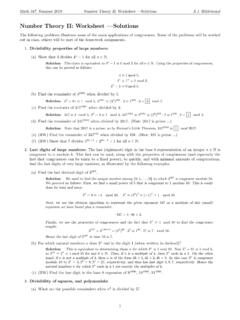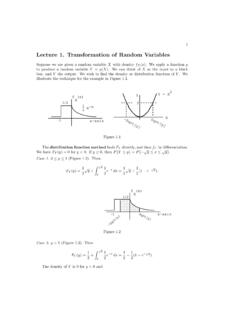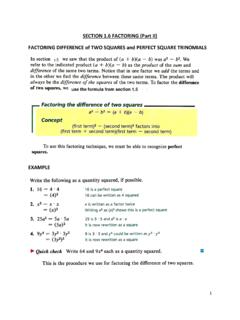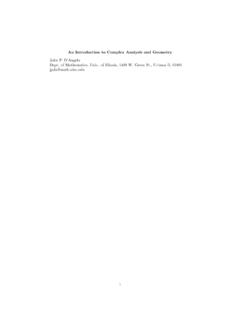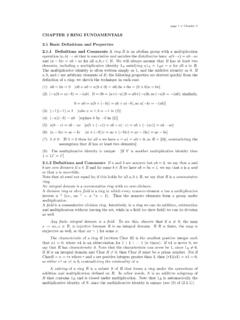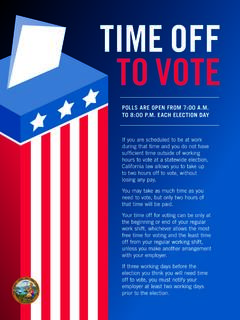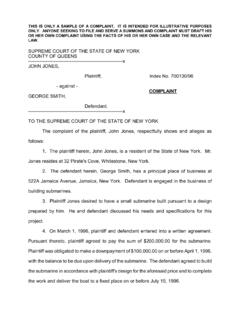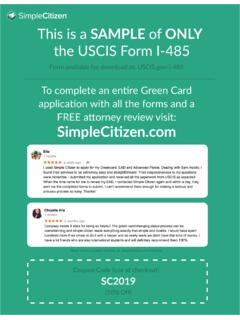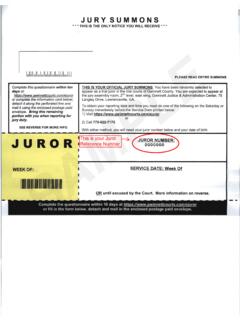Transcription of Sample Space, Events and Probability
1 Sample Space, Events and ProbabilitySample Space and EventsThere are lots of phenomena in nature, like tossing a coin or tossing a die, whose outcomescannot be predicted with certainty in advance, but the set of all the possible outcomes is are what we callrandom phenomenaorrandom experiments. Probability theory is concernedwith such random phenomena or random a random experiment. The set of all the possible outcomes is called thesample spaceof the experiment and is usually denoted byS. Any subsetEof the Sample spaceSis called anevent. Here are some 1 Tossing a coin. The Sample space isS={H, T}.E={H}is an 2 Tossing a die. The Sample space isS={1,2,3,4,5,6}.E={2,4,6}is an event,which can be described in words as the number is even .Example 3 Tossing a coin twice.
2 The Sample space isS={HH, HT, T H, T T}.E={HH, HT}is an event, which can be described in words as the first toss results in a 4 Tossing a die twice. The Sample space isS={(i, j) :i, j= 1,2, .. ,6}, which contains36 elements. The sum of the results of the two toss is equal to 10 is an 5 Choosing a point from the interval(0,1). The Sample space isS= (0,1).E=(1/3,1/2)is an 6 Measuring the lifetime of a lightbulb. The Sample space isS= [0, ).E= [90, )isan 7 Keeping on tossing a coin until one gets a Heads. The Sample space of this experimentisS={H, T H, T T H, T T T H, ..}.E={H, T H}is an thatEis an event. We say that the eventE occurs if the outcome of the experimentis contained Events are simply subsets of the Sample space, we can talk about various set theoreticoperations on Events .]]
3 In the following,E,F,G,Ei, = 1,2, ..are Fdenotes the union Fdenotes the intersection the complement ofE, that isE=S\ Fmeans thatEis a subset ofF. IfE F= ,we say thatEandFare , we can talk about the union and intersection of more than two Events : ni=1Ei, i=1Ei, ni=1Ei, i= we recall some properties of set theoretic operations:Commutativity:E F=F E, E F=F :(E F) G=E (F G),(E F) G=E (F G).Distributivity:(E F) G= (E G) (F G),(E F) G= (E G) (F G).De Morgan s law:( ni=1Ei)c= ni=1 Eci,( ni=1Ei)c= ni=1 Eci,( i=1Ei)c= i=1 Eci,( i=1Ei)c= i= of ProbabilityConsider an experiment with Sample spaceS. A real-valued functionPon the space of all eventsof the experiment is called a Probability measure if(i) for all eventsE, 0 P(E) 1;(ii)P(S) = 1;(iii) for any sequence of eventsE1, E2.
4 Which are mutually disjointP( n=1En) = n=1P(En).For any eventE, we refer toP(E) as the Probability are some 8 Tossing a fair coin. In this case, the Probability measure is given byP(H) =P(T) = the coin is not fair, the Probability measure will be 9 Tossing a fair die. In this case, the Probability measure is given byP(1) =P(2) = =P(6) =16. If the die is not fair, the Probability measure will be 10 Tossing a fair coin twice. In this case, the Probability measure is given byP(HH) =P(HT) =P(T H) =P(T T) = 11 Tossing a fair die twice. In this case, the Probability measure is given byP((i, j)) =136, i, j= 1, .. , 12 Tossing a point from{1, .. , n}at random, that is each point is equally likely to bechosen. In this case, the Probability measure is given byP(i) =1n, i= 1.
5 , 13 Choosing a point from the interval(a, b)at random, that is each point is equallylikely to be chosen. In this case, the Probability measure is given byP((c, d)) =d cb a,for all interval(c, d) (a, b).Example 14 Measuring the lifetime of a lightbulb. Depending on the manufacturer, the probabilitymeasure will be different. One possible Probability measure is given byP(E) = Ee tdt,for anyE [0, ).Example 15 Keeping on tossing a fair coin until one gets a Heads. In this case, the probabilitymeasure is given byP(H) =12,P(T H) =14,P(T T H) =18, ..The following result list some properties of Probability 16 Suppose thatPis a Probability measure. Then it satisfies the following properties.(i)P( ) = 0.(ii) For anyn 2, ifE1, .. , Enare disjoint Events , thenP( ni=1Ei) = ni=1P(Ei).]
6 (iii) IfE F, thenP(E) P(F).(iv) For any eventE,P(Ec) = 1 P(E).(v) For any eventsEandF,P(E F) =P(E) +P(F) P(E F).(vi) For anyn 2and any eventsE1, .. , En,P( ni=1Ei) =n i=1P(Ei) i1<i2P(Ei1 Ei2)+ +( 1)k+1 i1< <ikP( kj=1 Eij)+ +( 1)n+1P( ni=1Ei).The last formula is called the inclusion-exclusion are only going to prove (i), (ii), (v). (vi) follows from (v) and the prove (i), takeE1=S,E2=E3= = . ThenE1, E2, ..is a sequence of disjoint Events ,so we have1 =P(S) = n=1P(En) = 1 +P( ) +P( ) + .Consequently we haveP( ) = prove (ii), takeEn+1=En+2= = , thenE1, E2, ..is a sequence of disjoint Events , sowe haveP( ni=1Ei) =P( i=1Ei) = i=1P(Ei) =n i=1P(Ei).To prove (v), notice thatE= (E F) (E Fc),F= (E F) (F Ec) andE F=(E F) (E Fc) (F Ec). HenceP(E) =P(E F) +P(E Fc),P(F) =P(E F) +P(F Ec),P(E F) =P(E F) +P(E Fc) +P(F Ec).
7 (v) follows immediately from the three identities 17A fair die is tossed twice. Find the Probability that the sum of the two results is LetEbe the event that the sum of the two results is even. Fori= 2,4, ,12, letEibe the event that the sum of the two results isi. ThenE2, E4, , E12are disjoint andEis theunion ofE2, E4, , E12. One can easily find the Probability of eachEi, adding them up, we getP(E) = 18A fair die is tossed 100 times. Find the Probability that there is at least one LetEbe the event that there is at least one 5. ThenEcis the event that there is no5 andP(Ec) = (56)100. ThusP(E) = 1 (56) 19 Suppose thatEandFare two Events . If we know the probabilities ofE,FandE F, we can find the Probability of any set theoretic combination ofEandF.
8 For instance, ifP(E) =12,P(F) =13andP(E F) =14, thenP(E F) =P(E) +P(F) P(E F) =12+13 14andP(E Fc) =P(E) P(E F) =13

